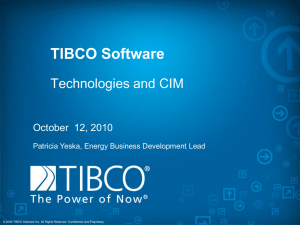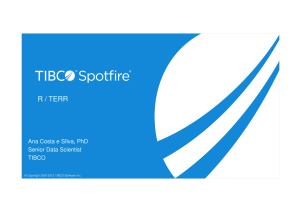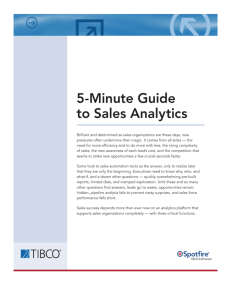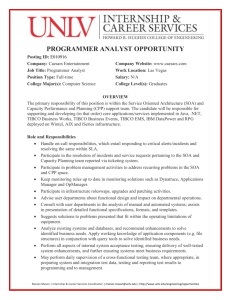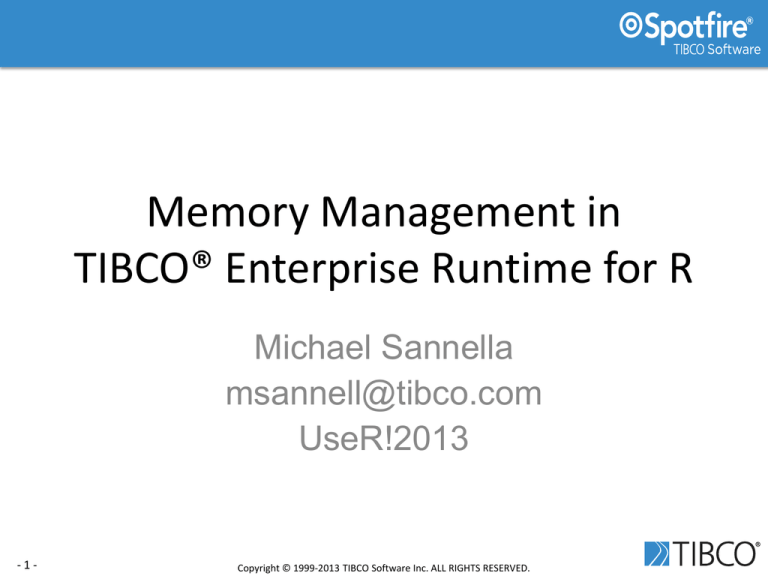
Memory Management in
TIBCO® Enterprise Runtime for R
Michael Sannella
msannell@tibco.com
UseR!2013
-1-
Copyright © 1999-2013 TIBCO Software Inc. ALL RIGHTS RESERVED.
What is TERR?
• TERR: TIBCO® Enterprise Runtime for R
• A new R-compatible statistics engine.
• The latest in a family of scripting engines.
– S, S-PLUS®, R, TERR
• Recently released with Spotfire® 5.0.
– Used to implement “predictive analytic tools”
• Free Developer's Edition available at:
www.TIBCOmmunity.com/community/
products/analytics/terr
• Commercially available for Spotfire and custom
integration.
-2-
Copyright © 1999-2013 TIBCO Software Inc. ALL RIGHTS RESERVED.
Building TERR
• We rebuilt the engine internals from scratch.
– Redesigned data object representation
– Redesigned memory management facilities
– Attempted to address long-standing problems
with S, S-PLUS®, R
• This talk will compare R and TERR designs for:
– Data representation
– Reference counting
– Garbage collection
-3-
Copyright © 1999-2013 TIBCO Software Inc. ALL RIGHTS RESERVED.
R: Data Representation
• Basic R data objects have a fixed representation in
memory.
– The contents of a vector is represented as a C array
– Data must be in memory
– Only one representation for a given type
• Example: An R numeric vector is represented as an
object containing a C double* pointer to an array in
memory.
• Can access object elements via simple memory access
operations.
– If USE_RINTERNALS is defined, REAL(pObj) will be compiled
as a simple memory access
-4-
Copyright © 1999-2013 TIBCO Software Inc. ALL RIGHTS RESERVED.
TERR: Data Representation
• TERR implements data objects via abstract C++ classes
with one or more representations.
– Manipulate object via C++ methods
– Doesn’t support direct access
– USE_RINTERNALS is not supported
• Scalar vs small vector vs big vector
– Different representations with different length fields
– Matrix of basic types and representations implemented via C++
templates
-5-
Copyright © 1999-2013 TIBCO Software Inc. ALL RIGHTS RESERVED.
TERR: Data Representation
• Sequence objects: 1:1e6
> x <- 1:1e6
> object.size(x)
104 bytes
> x[1] <- 0
> object.size(x)
8000088 bytes
• String sequences: as.character(1:1e6)
– Used for data.frame row names
• Two representations for logical vectors:
– Normal logical vectors have 1-byte elements
– C code NEW_LOGICAL(n) creates logical vectors with 4-byte
elements
-6-
Copyright © 1999-2013 TIBCO Software Inc. ALL RIGHTS RESERVED.
TERR: Potential Future Data Representation
• Extend preliminary support for out-of-memory vectors.
– Transparent “bigdata” objects
– Only use external files when necessary
• Access shared memory between applications.
– Example: Send data between Spotfire and TERR
• Access database tables.
• Access streaming data.
• Represent deferred evaluation “futures”
– Example: An object representing the result of adding two vectors
B and C, only performing the addition when needed
– See: Riposte runtime, Talbot et al., UseR2012
-7-
Copyright © 1999-2013 TIBCO Software Inc. ALL RIGHTS RESERVED.
Reference Counts
• R and TERR use reference counts to efficiently
implement object modification semantics.
• If an object has only one reference, we can modify it
without copying it.
x <x[1]
y <x[2]
-8-
rnorm(1e6)
<- 0 # only one reference: modify in place
x
<- 0 # two references: copy before modify
Copyright © 1999-2013 TIBCO Software Inc. ALL RIGHTS RESERVED.
Reference Count Field
• R objects contain 2-bit reference count
– “named” field
– Easy to make examples that set reference count to “max” value
that will never be decreased
– Max reference count copy on change
• TERR objects contain 16-bit reference counts
– Tracks number of references up and down
– Identify more objects that can be modified in place, without
copying
-9-
Copyright © 1999-2013 TIBCO Software Inc. ALL RIGHTS RESERVED.
One Reference: No Copy
refcnt.0 <- function(n) {
z <- as.numeric(1:n)
for(x in 1:n) {
# only one reference to vector
# so no copy is done
z[x] <- z[x]+1
}
z
}
- 10 -
Copyright © 1999-2013 TIBCO Software Inc. ALL RIGHTS RESERVED.
Two References
refcnt.1 <- function(n) {
z <- as.numeric(1:n)
for(x in 1:n) {
z2 <- z
# temporarily add
z2 <- NULL # second reference
z[x] <- z[x]+1
}
z
}
- 11 -
Copyright © 1999-2013 TIBCO Software Inc. ALL RIGHTS RESERVED.
Two References via Function Call
refcnt.2 <- function(n) {
z <- as.numeric(1:n)
fn <- function(vec,idx) vec[idx]+1
for(x in 1:n) {
# temporarily add second reference
# while calling function
z[x] <- fn(z,x)
}
z
}
- 12 -
Copyright © 1999-2013 TIBCO Software Inc. ALL RIGHTS RESERVED.
Reference Count Tests: Performance
- 13 -
Copyright © 1999-2013 TIBCO Software Inc. ALL RIGHTS RESERVED.
Reference Count Tests: Performance
- 14 -
Copyright © 1999-2013 TIBCO Software Inc. ALL RIGHTS RESERVED.
R: Garbage Collection
• R uses a mark-and-sweep garbage collector to reclaim
storage for unused objects.
• The R garbage collector is a generational garbage
collector.
– Quick sweep through “young” objects to reclaim temporary
objects
- 15 -
Copyright © 1999-2013 TIBCO Software Inc. ALL RIGHTS RESERVED.
TERR: Garbage Collection
• TERR uses a mark-and-sweep garbage collector along
with reference counts to reclaim storage.
– When an object reference count goes to zero, can immediately
reclaim temporary object
– Calls full mark-and-sweep garbage collection (infrequently)
• After engine initialization:
– Set “static” objects to have the max reference count
– Don’t scan on future garbage collections
- 16 -
Copyright © 1999-2013 TIBCO Software Inc. ALL RIGHTS RESERVED.
Row-By-Row Test: Translated SAS®
• Suppose we have a SAS® “data step” with complex logic
for processing records one row at a time.
• Suppose we hand-translate each line directly into R
code.
– Of course, this is not going to be efficient, since R is not suited to
row-by-row operations
– However, the user may not want to entirely recode in a
vectorized form, distorting the original logic
• Question: How fast will this “non-optimized” code run in
R and TERR?
- 17 -
Copyright © 1999-2013 TIBCO Software Inc. ALL RIGHTS RESERVED.
Row-By-Row Test: SAS® Code
. . .
ELSE IF event='complaint' AND startDate NE . THEN DO;
lastComplaintDate = date;
weeknum = 1+(date-startDate)/(7*24*60*60);
IF weeknum<2 THEN DO;
comp1 = comp1+1;
END;
ELSE IF weeknum<3 THEN DO;
comp2 = comp2+1;
END;
ELSE DO;
compN = compN+1;
END;
. . .
- 18 -
Copyright © 1999-2013 TIBCO Software Inc. ALL RIGHTS RESERVED.
Row-By-Row Test: R Code
. . .
} else if (df.event[i]=="complaint" &&
!is.na(startDate)) {
lastComplaintDate <- df.date[i]
weeknum <- 1 + as.numeric(difftime(df.date[i],
startDate, units="days"))/7
if (weeknum<2) {
comp1 <- comp1+1
} else if (weeknum<3) {
comp2 <- comp2+1
} else {
compN <- compN+1
}
. . .
- 19 -
Copyright © 1999-2013 TIBCO Software Inc. ALL RIGHTS RESERVED.
Row-By-Row Test: Performance
- 20 -
Copyright © 1999-2013 TIBCO Software Inc. ALL RIGHTS RESERVED.
Row-By-Row Test: Performance
- 21 -
Copyright © 1999-2013 TIBCO Software Inc. ALL RIGHTS RESERVED.
Row-By-Row Test: Garbage Collection
• R-3.0.1:
# before processing 1M rows
Garbage collection 67 = 26+6+35 (level 2)
# after processing 1M rows
Garbage collection 40300 = 30966+7745+1589 (level 2)
• TERR:
# before processing 1M rows
40 collections
# after processing 1M rows
42 collections
- 22 -
Copyright © 1999-2013 TIBCO Software Inc. ALL RIGHTS RESERVED.
Row-By-Row Test: Analysis
• We strongly suspect that the R performance problem is
due to frequent garbage collections to reclaim temporary
objects.
• In TERR, most temporary objects are immediately
reclaimed using reference counts.
- 23 -
Copyright © 1999-2013 TIBCO Software Inc. ALL RIGHTS RESERVED.
Conclusion
• TERR internals were redesigned from scratch to support
better memory management and performance.
• TERR internal data representation supports further
experiments with more efficient objects.
• Full reference counting reduces unnecessary copies,
and improves garbage collection performance.
- 24 -
Copyright © 1999-2013 TIBCO Software Inc. ALL RIGHTS RESERVED.

